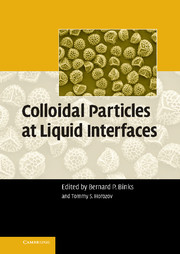Book contents
- Frontmatter
- Contents
- Preface
- List of Contributors
- 1 Colloidal Particles at Liquid Interfaces: An Introduction
- Section 1 Particles at Planar Liquid Interfaces
- Section 2 Particles at Curved Liquid Interfaces
- 5 Particle-Laden Interfaces: Rheology, Coalescence, Adhesion and Buckling
- 6 Solids-Stabilized Emulsions: A Review
- 7 Novel Materials Derived from Particles Assembled on Liquid Surfaces
- 8 Interfacial Particles in Food Emulsions and Foams
- 9 Collection and Attachment of Particles by Air Bubbles in Froth Flotation
- 10 Antifoam Effects of Solid Particles, Oil Drops and Oil—Solid Compounds in Aqueous Foams
- 11 Metal Foams: Towards High-Temperature Colloid Chemistry
- Index
8 - Interfacial Particles in Food Emulsions and Foams
Published online by Cambridge University Press: 11 October 2009
- Frontmatter
- Contents
- Preface
- List of Contributors
- 1 Colloidal Particles at Liquid Interfaces: An Introduction
- Section 1 Particles at Planar Liquid Interfaces
- Section 2 Particles at Curved Liquid Interfaces
- 5 Particle-Laden Interfaces: Rheology, Coalescence, Adhesion and Buckling
- 6 Solids-Stabilized Emulsions: A Review
- 7 Novel Materials Derived from Particles Assembled on Liquid Surfaces
- 8 Interfacial Particles in Food Emulsions and Foams
- 9 Collection and Attachment of Particles by Air Bubbles in Froth Flotation
- 10 Antifoam Effects of Solid Particles, Oil Drops and Oil—Solid Compounds in Aqueous Foams
- 11 Metal Foams: Towards High-Temperature Colloid Chemistry
- Index
Summary
Introduction
Many food colloids are stabilized, at least in part, by the presence of particulate material that accumulates at oil–water or air–water interfaces. As applied to emulsion droplets, this type of stabilization mechanism is commonly referred to as Pickering stabilization. Some examples of particles involved in Pickering stabilization in food emulsions are casein micelles (in homogenized milk), egg-yolk lipoprotein granules (in mayonnaise) and fat crystals (in spreads and margarine). In addition, dairy-type foams such as whipped creams and toppings are stabilized by a protective layer of partially aggregated emulsion droplets (or fat crystals) which adhere to the air bubbles during whipping.
This chapter reviews recent progress in the making and stabilization of food emulsions and foams using solid particles. To put the topic into context, we need to make direct comparison with the interfacial and stabilizing roles of the key molecular species – emulsifiers, proteins and hydrocolloids. It will be assumed that the reader is familiar with the basic physico-chemical principles of surfactant and polymer adsorption, with the meaning of terms commonly used in colloid science like “flocculation” and “coalescence”, and with the essence of the established theories of stabilization (and destabilization) of food emulsions and foams, as described in existing texts.
- Type
- Chapter
- Information
- Colloidal Particles at Liquid Interfaces , pp. 298 - 327Publisher: Cambridge University PressPrint publication year: 2006
- 15
- Cited by



